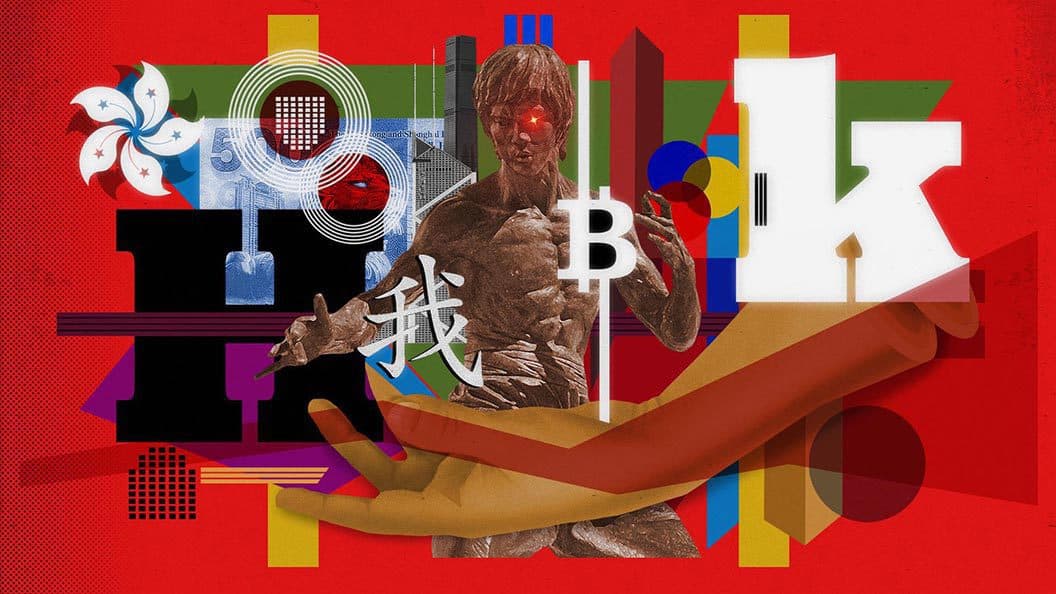Hong Kong’s Monetary Authority Studying CBDCs With FinTech 2025 Plan
As Singapore looks to steal Hong Kong’s status as Asia’s financial hub, the territory’s central bank wants to “future-proof” its claims

Blockworks exclusive art by Axel Rangel
key takeaways
- The HKMA said its working on retail CBDCs with the Bank of International Settlements and wholesale CBDCs (geared for cross-border large payments) with the People’s Bank of China
- Eddie Yue, the CEO of the HKMA, calls FinTech the “growth engine” for the post-pandemic era
As Beijing puts the final touches on China’s central bank digital currency (CBDC), the eCNY, authorities at Hong Kong’s central bank have laid out how the semi-autonomous territory and financial hub will approach the new payment type.
In a release on Tuesday, the HKMA said it was targeting a comprehensive fintech adoption by 2025 and CBDCs would be at the center of this. The bank said it’s been working with the Bank of International Settlements to research retail CBDCs — which target consumers and attempt to replace cash — and China’s central bank, the People’s Bank of China, to create a CBDC for wholesale cross border payments between the CNY and Hong Kong Dollar.
Arguably the latter is the more important endeavor, as Hong Kong is home to the world’s biggest offshore liquidity pool of the Chinese yuan. As Beijing looked to double-down on internationalizing its currency after the 2008 global financial crisis it picked Hong Kong as the hub for currency swaps and settlement for foreign trade.
Given the limited international convertibility of the Chinese currency, Hong Kong — with its freely convertible US-pegged Hong Kong dollar — is a strategic hub to ensure that the CNY remains liquid against other global currencies.
Should Beijing want the eCNY to be used for global trade and liquid on international markets, it would effectively need to create a similar venue in Hong Kong for offshore currency swaps. This doesn’t necessarily mean that Beijing is looking to challenge the US dollar, however, as during a recent CBDC panel at CoinDesk’s Consensus conference experts said that the goal for now is regionalization, not internationalizing, of China’s currency.
“Hong Kong people, nowadays, are more willing to use digital banking services. In addition, many overseas central banks have studied digital currencies. It is the right time for the HKMA to explore if we should have an e-Hong Kong dollar,” HKMA CEO Eddie Yue said in a public statement. “The HKMA has set up a working group to study the technology and regulatory issues related to an e-Hong Kong dollar. We will reach a conclusion in about 12 months.”
Hong Kong’s fintech future
Aside from promoting CBDCs, the other goal of the HKMA’s FinTech 2025 plan is to create a workforce ready for a growing fintech industry. This plan would attempt to bridge industry and academia to develop education programs that would ready students to be the workforce of the future.
“Fintech is, without doubt, a key growth engine for the financial industry in the post-pandemic era, and now is the right time to double down on our efforts to grasp the opportunities,” Yue said.
But the HKMA might run into a barrier here: a lack of interest from young, tech-savvy employees. Many recent graduates prefer to work for big, established banks rather than startups citing the job security and prestige of a name like HSBC on their resume.
In an earlier interview with Blockworks, Jason Choi, an executive at Spartan Group, a digital asset fund, said that the lack of a domestic tech industry and small population base compared to neighbouring China meant that it just wasn’t the place to scale a startup.
“Hong Kong, as a separate market with a different language and much smaller total addressable market of just about 8 million people is not really set up to be the place where you can just grow a startup natively and expect to achieve massive scale,” he said.
Last year, the Financial Times reported that despite many government initiatives like Cyberport, which provides highly subsidized offices for local startups and helps with venture capital matchmaking, the city had half the number of people working in startups as Singapore — and no globally recognized ‘unicorns’ as a result of its efforts.





